
Lakanto goes everywhere, Try it in coffee, baked good and in recipes
LAKANTO is the only Zero Calories, Zero Glycemic sweetener that looks like sugar, taste like sugar.

Originally, we had started developing a low calorie sweetener at Saraya using licorice and Stevia extracts. However, we were concerned that licorice and Stevia's unique flavors were too prominent for a sweetener, and wondered if there was a better natural sweetener out there.
We encountered the luo han guo fruit during our search for a new plant based sweetener. At that time, the only luo han guo fruit extract based foods available in Japan were very bitter and caused burning sensation in the throat. As a result, there were only a handful of luo han guo based foods in Japan. However, after studying the fruit's properties in our laboratory, we found out that the sweetening compound in luo han guo displayed many similarity with sugar.
After reporting these findings to my boss, we immediately decided to fly to China. This was the start of my journey to develop a good tasting, natural sweetener with zero calories.
After learning that the luo han guo is only grown around the Chinese city of Guilin we decided to head there to see the actual plants. Upon arriving, I enrolled the cooperation of local officials to help us learn about the fruit and any potential uses for it in our project. A local university professor brought us to visit our first luo han guo plantation. I will always remember the first time I tasted the fresh fruit. It was neither bitter nor harsh, but very sweet. The flavor invades my mouth so quickly, and I remember being blown away by the potential of the fruit. It exceeded all my expectations.
Currently, luo han guo can be grown in the flat lands, but back then the fruit was only cultivated high above in the mountains, only accessible by crossing over steep slopes. It took us 2 to 3 hours by car from Guilin to get to the fields. Often times, we had to get out and push the car through muddy parts of the road. You would also have to climb to the plantation on foot for the last 40 minutes of the trip.

This was how we were first introduced the luo han guo in China, and since then the area of Guilin has given me the tools to create a wonderful natural sweetener with zero calories. It has already now been 8 years since we started selling Lakanto, but the memory of my first taste of luo han guo fruit is till vivid in my mind. I have been engaged since then to improve the way we extract the sweetening compound. Already patented, my goal is now to continually improve the features of Lakanto.
Now I'll speak a little about the features of the luo han guo fruit.
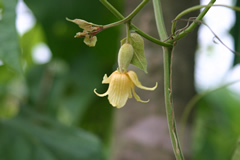
The name luo han guo is derived from the extremely long name, Siraitia grosvenorii C. Jeffrey ex A.M Lu et Zhi Y. Zhang (Momordica grosvenori Swingle).
The luo han guo fruit grows throughout the regions of Lingui, Quanzhou, Mengshan, and Rong'an in southern China. This area is known for its breathtaking scenery and is located about 100 km northwest of Guilin. This mountainous region is also known for the large temperature difference between night and day, but despite this, this climate is idea for luo han guo cultivation.
The name luo han guo originated in the Qing dynasty, in the city of Guilin. The name pays tribute to the doctor Luo Han from the Yao tribe who first taught the fruit's medicinal properties.
The luo han guo fruit has a variety of related fruits. Among them, the most well known are: Chang Tan Guo, Qing Pi Guo, Dong Gua Guo, and La Jiang Guo.
The Chang Tan Guo fruit is the highest quality luo han guo fruit. This fruit's crop yields are very low and can only be cultivated in a limited area. Its optimum conditions are mountainous areas located 300~500m above sea level.
The Qing Pi Guo is a luo han guo fruit type developed in the 1960s for high crop yield. As a result, it makes up for 90% of the yearly luo han guo fruit production. This type of fruit is especially susceptible to insects.

The Dong Gua Guo fruit that has been grown for a very long time in the mountainous regions 700~900m above sea level. It is generally regarded as a high quality luo han guo, and gives high yields during harvest. However, the high altitude needed to grow this species is particularly prohibiting.
The La Jiang Guo is a decent quality luo han guo that is highly resistant to insects but cultivation requires a lot of technical skills and is therefore not favored by farmers. All luo han guo have beautiful yellow flowers that blossom every year between June and August. Their seeding period may go from August to October but harvest will start in September and last until November.
The luo han guo are round or oval in shape. Depending on the fruit type, dimensions may vary, but they will all be about 4~6cm in diameter and covered with a fine hair. Once the fruit is ripe, it will take on a deep green color. The plant itself grows in a terrace-like setting, with a main root extending to the earth.
A few years ago more scientific interest was taken in the fruit, and since then research has been conducted to improve the plant's quality as a crop. In recent years, I have seen luo han guo with diameters above 7~8cm.
I am sure in the future we will see more research on the cultivation of luo han guo with even more functional properties.
You will find out more in Chapter 3 on luo han guo cultivation.
You will find out more in Chapter 3 on luo han guo cultivation.
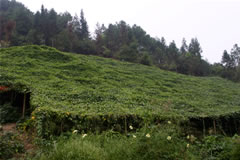
Luo han guo is optimized for cultivation in subtropical mountainous areas with the following criteria.
The luo han guo blossoms between June and August with yellow flowers. Insects cannot completely pollinate a plantation, so manual pollination is usually used to fertilize the flowers individually.
Luo han guo fields are usually spread along the mountain side. Fields can be 10 times the size of a baseball field. The yellow flowers spread endlessly across the mountain side, and I imagine the pollination process is quite a difficult task moving from one flower to the next. From August to October when the fruit begins to develop, the stalk raises the plant up like a shelf. Mainly mountains with good water drainage are used.
Increasing demand for luo han guo has lead to greater research into the field of cultivation. Rather than simply replanting seeds year after year, new techniques and plant strains are being researched to increase yield and viability of the plans to increase production.
Recently, agricultural scientists have found ways to cultivate luo han guo on flat land.
Harvest takes place from September to November, with the fruit picked individually by hand. I remember farmers carrying 60kg loads of fruit down the steep mountain.
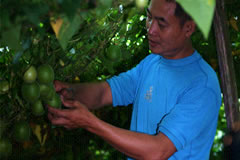
However, with the recent development of flat land growing, fruit loads can now be brought to nearby trucks with increased efficiency.
That said, after the seeds have been planted and artificial fertilization taken place, it always takes several months before harvest time.
Unlike numerous recently commercialized synthetic sweeteners, Lakanto is based on a natural plant, meaning Lakanto depends on the previous harvest, so we cannot guarantee the amount of Lakanto manufactured from year to year. The cultivation of luo han guo requires a large amount of investment, but regardless of the harvest, the safety and quality and nutrition of the product is guaranteed.
Most normal fruits and vegetables are sold immediately after harvesting. But luo han guo must be further processed to extract the sweet essence before processing it into Lakanto. This extra step delays the production, but makes Lakanto very unique and natural.
You will find out more on Chapter 4 about luo han guo extraction and purification methods.

As previously mentioned in chapter 3, pollination and harvesting are done on a fruit by fruit basis by hand.
The many steps taken to produce Lakanto make it much different from normal synthetic sweeteners. Once luo han guo seeds are planted it is still many months before pollination and harvesting can begin.
Most fruits and vegetables are sold in the market soon after harvesting, but lou han guo must be processed again before sale.
Luo han guo used in Lakanto is pesticide free, but it is washed before processing to remove any dirt. The fruit is then put in an extraction tank where hot water is used to draw out the sweet extract. No pre-processing such as roasting is used due to its are then washed before being placed in an extraction device to bring out luo han guo's sweet essence. Our process maintains the freshness of the fruit as long as possible to get the best flavor and sweetness. Once the hot water extraction is complete, any moisture is removed to concentrate it future. Finally, the extract is enriched in a low temperature vacuum chamber to purify the concentration further. Though the process is long and complicated, the end result is a sweet and mild tasting fruit extract of higher quality than any other.
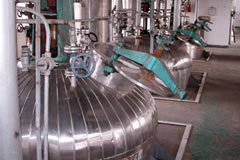
The production of natural sweeteners can be thought of similar to producing wine. Each year's supply depends on the harvest of raw materials. While Lakanto had many more risks and investments compared to synthetic sweeteners, the consumption of Lakanto is proven to be safe.
Making a fruit extract is quite easy. However, with Lakanto, we only want to have the sweet glycosides from the fruit extract. Removing this is very difficult without having too much excess fruit material. With the method listed above, we have been able to successfully remove luo han guo's pure extract of glycosides, several hundred times sweeter than sugar.
You will find out more on the luo han guo purification method in Chapter 5.
Luo han guo's unique feature it its amazing sweetness which is 300 to 400 sweeter than sugar.
The luo han guo fruit has a long history of culinary and medicinal uses in China and Southeast Asia, and its low calorie, sweet profile makes it perfectly suited for people suffering from diabetes or lifestyle related diseases.
In order to evaluate the sweetness of luo han guo, an experiment was conducted on 15 healthy participants sampling several basic sweeteners.
We asked each participant to evaluate each sample according to the following characteristics: 1) Bitterness; 2) After taste; 3) Strength; 4) Unique Flavor; 5) Astringency 6) Irritation; 7) Purity; 8) Mellowness. The results are shown below.
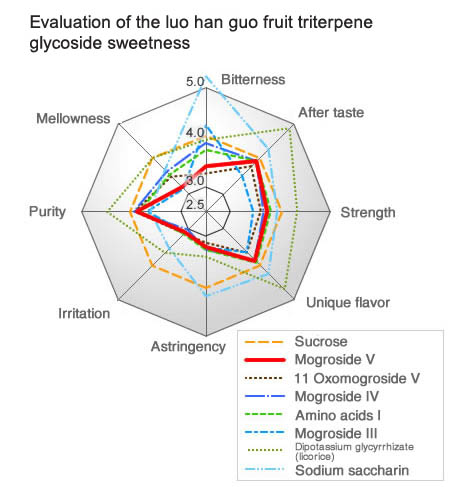
The farther away from the center, the less favorable the sweetness is compared to sugar.
The result shows that the sweetening ingredient Mogroside V found in the luo han guo, even compared to other sweeteners, displays characteristics close to sucrose (sugar). This test indicates that the sweetening compound found in luo han guo is ideal as a sugar replacement. Many other natural and artificial sweeteners have flavor characteristics that can affect food flavors, but Lakanto's Mogroside V is nearly perfect.